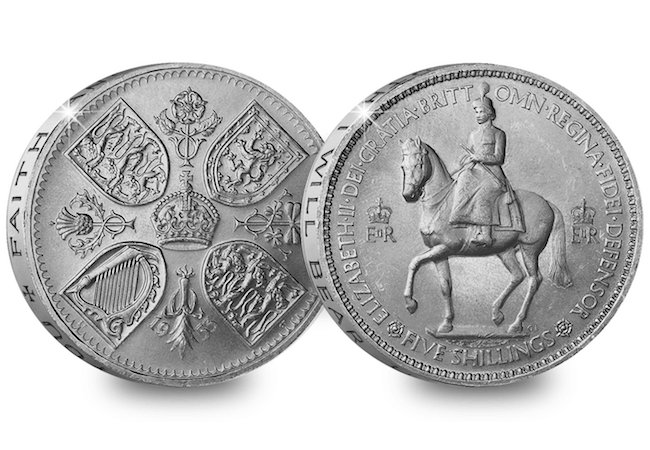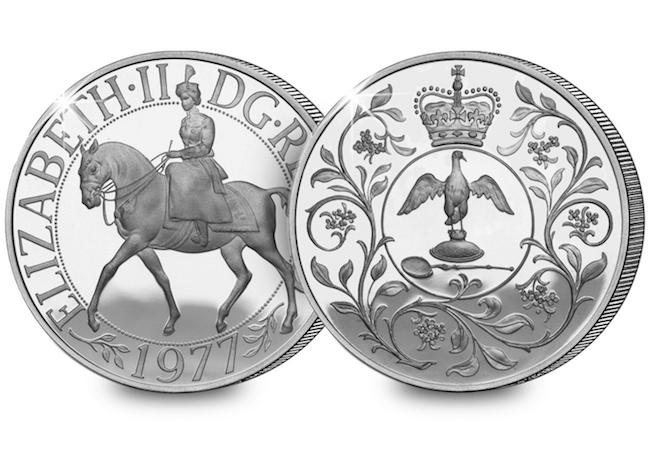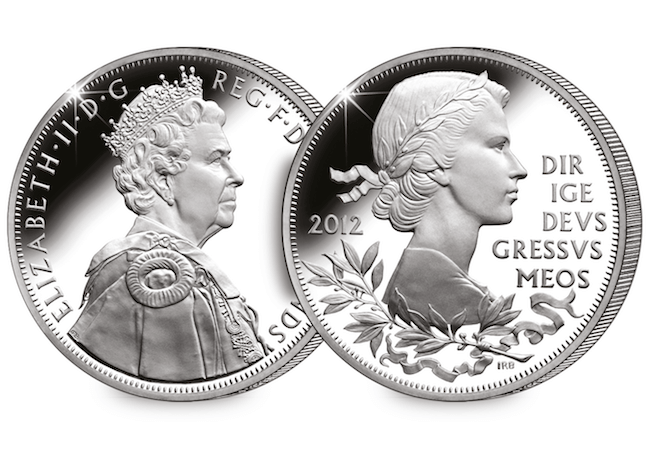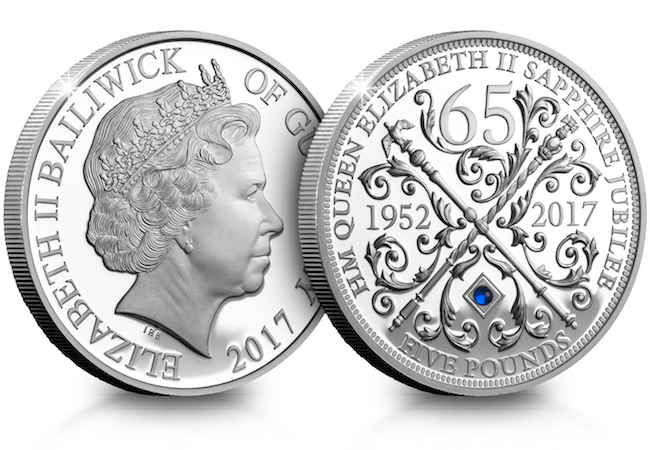Coins
The history of Her Majesty’s Jubilee crown coins…
This year Her Majesty Queen Elizabeth II celebrates her Sapphire Jubilee – the first ever British monarch in history to do so. To mark the occasion, a brand new British Isles £5 Proof coin has been issued featuring a sparkling sapphire crystal as a truly fitting tribute to Her Majesty’s record-breaking reign.
In light of its release, I thought I’d take a look at the history and timeless designs of previous British Jubilee commemorative coins issued during the Queen’s reign…
The 1953 Coronation UK Crown
The 1953 crown was issued to celebrate Her Majesty’s Coronation and was the very first UK commemorative coin to be issued during Queen Elizabeth II’s reign. Unusually, the obverse portrait features an engraving of the Queen riding on horseback at the Trooping of the Colour ceremony in 1953 with an edge inscription which reads ‘Faith and Truth I will bear Unto You’, taken from the Coronation Oath. The Coronation crown was to form the basis of future Jubilee commemorative crown designs and still remains one of the most sought-after by collectors. It is often the starting point for many great collections.
The Silver Jubilee UK Crown
In 1977, Her Majesty celebrated 25 years on the throne – her Silver Jubilee and the first of her reign. To celebrate the occasion, a new commemorative crown was issued by the Royal Mint designed by renowned sculptor and designer of the Queen’s portrait on the UK’s stamps, Arnold Machin. The coin’s reverse design is focused upon the Coronation theme and features the Ampulla and anointing spoon from the Royal regalia surrounded by a heraldic floral pattern and the Crown.
The coin’s obverse takes inspiration from the 1953 Coronation Crown, showing a newly designed image of the Queen on horseback. Unusually, this is the only crown in British history not to feature an edge inscription or date on its reverse and is one of the last crowns to be issued with a face value of 25 pence (commemorative crowns issued after 1990 have a face value of £5), which makes it continually sought-after among collectors.
The Golden Jubilee UK Crown
2002 saw the Queen’s Golden Jubilee, marking her 50th year on the throne and the release of a new commemorative, this time, issued with a face value of £5 . The coin was designed and sculpted by Ian Rank-Broadley FRBS, who created the fourth portrait of the Queen on the obverse of our UK circulating coins. The reverse design once again, features a newly designed image of Her Majesty on horseback inspired by the original Coronation crown design. The reverse features a specially designed portrait of the Queen.
The Diamond Jubilee UK Crown
In 2012, the nation witnessed the Queen’s Diamond Jubilee. Sixty years on the throne is a landmark milestone and one that has only been reached by one other monarch – Queen Victoria in 1897. This is the first ever coin to be struck to mark a Diamond Jubilee because there were no special coins issued for Queen Victoria’s.
Special one-off portrait designs
To mark such a momentous occasion, Ian Rank-Broadley FRBS was once again commissioned to design the coin. The obverse features a portrait of Her Majesty crowned and wearing the robes of the Order of the Garter, inspired by the sculpture that appears in the entrance of the Supreme Court building in Parliament Square. The reverse design shows a portrait of the Young Queen inspired by Mary Gillick’s portrait of Her Majesty, the very first to feature on the obverse of the UK coins in 1953.
The Sapphire Jubilee £5 Guernsey Coin
2017 marks Her Majesty Queen Elizabeth II’s 65th year on the throne, the first ever British Monarch in British history to do so. To mark such a landmark, historic occasion, this brand new limited edition £5 Proof coin has been issued by the Bailiwick of Guernsey.
Fully approved by Her Majesty the Queen, the design by ex-Royal Mint engraver, Michael Guilfoyle features the Sovereign’s crossed sceptres from the Coronation regalia with the number 65 marking the years Her Majesty has been on the throne with a stunning crystal inset into the design representing a blue sapphire.
You can now own the new Guernsey Sapphire Jubilee Proof £5 Coin today.
With a low edition limit of just 4,950 worldwide in such a landmark year, demand for this limited edition special Proof coin is expected to be high.
Revealed: The Royal Mint UK commemorative coin designs for 2017
Each year, The Royal Mint marks important British anniversaries, events or accomplishments on our coins and today we are pleased to reveal UK’s new coin designs for 2017.
Scroll down and I’m sure you’ll agree 2017 is set to be another significant year for coin collectors, with some exceptional designs that are sure to look resplendent when struck to the ‘collector’s favourite’ Proof finish…
The Sir Isaac Newton 50p
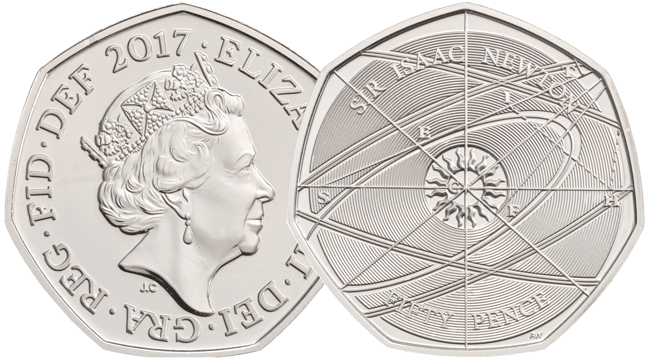
This 50p coin has been issued to mark the outstanding achievements of Sir Isaac Newton and has been designed by Aaron West.
The 50p coin commemorates the revolutionary scientific and mathematical genius, Sir Isaac Newton and his remarkable legacy. He discovered the laws of gravity and motion and remains one of the most famous men in history. This coin really needs to be seen in real life as the concentric design cleverly catches the light differently from every angle.
The Jane Austen £2 Coin

The 2017 Jane Austen UK £2 Coin
2017 sees the 200th anniversary of Jane Austen’s death – and this £2 has been specially designed to commemorate one of the most famous authors of all time. Featuring an unusual ‘cameo’ design and Austen’s signature, this coin is sure to be highly sought-after.
The First World War Aviation £2 Coin

The 2017 First World War Aviation UK £2 Coin
The latest in The Royal Mint’s series of two pound coins commemorating World War I, this particular issue pays tribute to the role of the air force in the conflict. Designed by tangerine the striking aerial perspective is a first for a UK £2 coin.
The House of Windsor £5 Coin
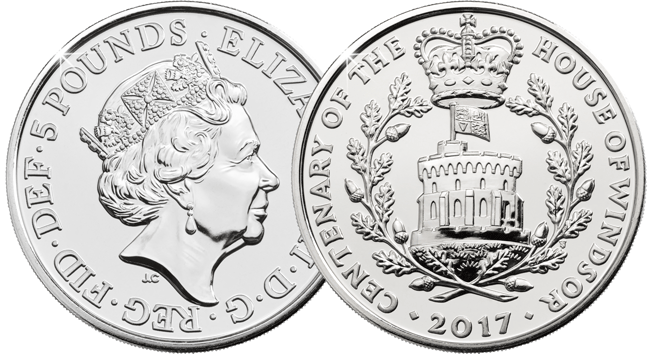
The 2017 House of Windsor UK £5 Coin
100 years of Royal tradition are honoured with this exceptional £5 coin – commemorating the Centenary of the House of Windsor. In 1917 King George V changed the name of the British Royal Family from Saxe-Coburg and Gotha to the now familiar Windsor. The coin’s pleasingly traditional design features Windsor Castle.
The King Canute £5 Coin

The 2017 King Canute UK £5 Coin
In a nod to Britain’s storied history, the second 2017 £5 coin marks the 1,000th anniversary of King Canute’s accession to the throne. Most famous for his attempts to prove his power by turning back the tide, Canute is also hailed as the first ‘king of all England.’
Some of these designs are really exceptional, and they are certain to become more sought-after in years to come. Which is your favourite? Let us know in the comments!
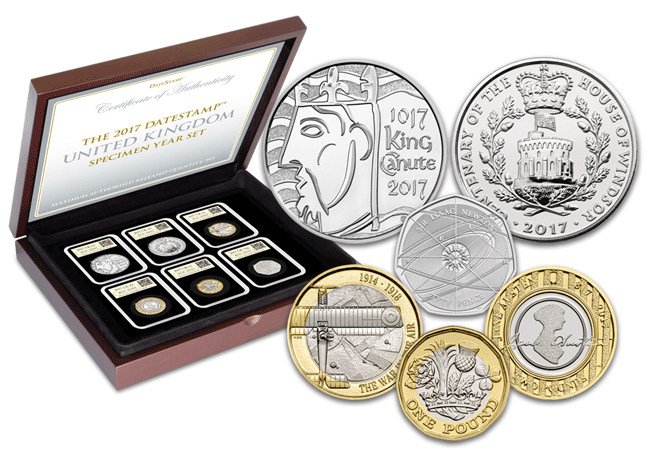 If you’re interested…
If you’re interested…
You can now own all the new 2017 coins in the DateStamp™ UK Specimen Year Set. Each coin has been struck to Brilliant Uncirculated quality and encapsulated alongside a 1st Class Stamp officially postmarked by Royal Mail with the issue date – 1/1/2017. Click here for more details…
The story behind the official 2016 ‘Lest We Forget’ Poppy Coin
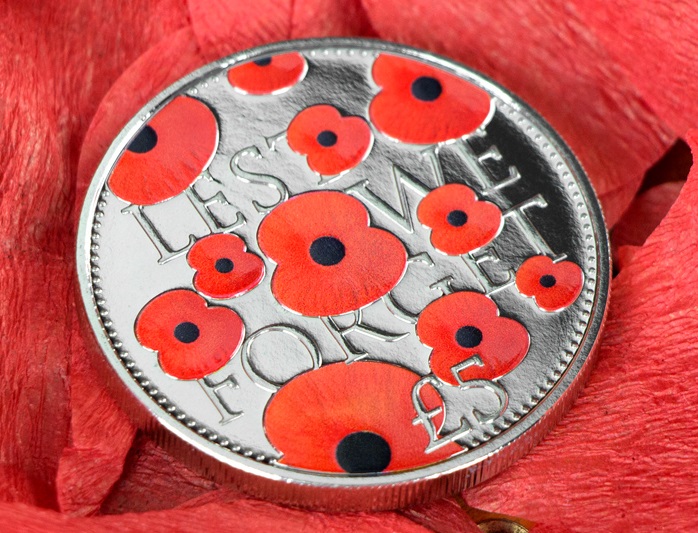
The Official 2016 “Lest We Forget” £5 Poppy Coin
The official new Poppy Coin has just been issued in support of The Royal British Legion, and this year it is especially poignant.
2016 is a milestone year as it marks the 100th anniversary of the Battle of the Somme, the First World War battle that has come to symbolise the awful tragedy of the conflict.
To pay respect to those who served, the new coin’s design has been inspired by the falling poppies at the annual Festival of Remembrance – held in the Royal Albert Hall.
I caught up with designer Matt Tindall to ask him about the design:

Matt Tindall, designer of the Official Poppy Coin 2016
“As this is the only official Poppy coin issued in support of The Royal British Legion I wanted to make sure the design was instantly recognisable, yet also had a subtle reference to the importance of the year 2016.
“The wording “Lest We Forget” from Laurence Binyon’s Ode of Remembrance seemed particularly fitting – and the quotation is covered by 11 falling poppies which of course represent the 11th hour of the 11th day of the 11th month.

Designing the official 2016 Poppy Coin
“My grandfather served during the First World War in the South Staffordshire Regiment so it was a real honour to be asked to design the Poppy Coin. The Royal British Legion has always had such an important role in this country and I only hope this coin goes some way to helping their work.”
A coin for everybody
A whole range of different coin specifications are to be struck, meaning there is a coin for every collection. From a special Proof quality cupro-nickel £5 coin – right up to an astonishing 5oz Gold edition, the new Poppy Coin is undoubtedly a moving tribute for Remembrance Day in this historic year.
Officially issued in support of The Royal British Legion
To support the work of The Royal British Legion, The Westminster Collection have organised for a donation from the sale of each coin to go directly to the charity, helping them to continue to provide financial, social and emotional support to all who have served and are currently serving in the British Armed Forces and their families.
If you’re interested…
The 2016 “Lest We Forget” Proof £5 Poppy Coin is available now. Click here for more details and to add one to your collection today…
A donation from the sale of each coin will go directly to The Royal British Legion.


